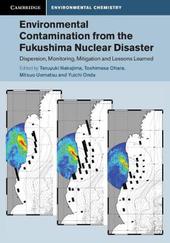
|
Environmental Contamination from the Fukushima Nuclear Disaster: Dispersion, Monitoring, Mitigation and Lessons Learned
Hardback
Main Details
Description
The 2011 disaster at the Fukushima Daiichi Nuclear Power Station led to serious radioactive contamination of the environment. Due to transportation by seasonal wind and ocean currents, these radioactive materials have now been observed in many places in the Northern Hemisphere. This book provides a unique summary of the environmental impact of the unprecedented accident. It covers how radioactive materials were transported through the atmosphere, oceans and land. The techniques used to investigate the deposition and migration processes are also discussed including atmospheric observation, soil mapping, forest and ecosystem investigations, and numerical simulations. With chapters written by international experts, this is a crucial resource for researchers working on the dispersion and impact of radionuclides in the environment. It also provides essential knowledge for nuclear engineers, social scientists and policymakers to help develop suitable mitigation measures to prepare for similar large-scale natural hazards in the future.
Author Biography
Teruyuki Nakajima is an Emeritus Professor at the University of Tokyo. He is currently serving as Chief Scientist of the Earth Observation Research Center (EROC) at the Japan Aerospace Exploration Agency (JAXA); and as Secretary General of IAMAS (International Association of Meteorology and Atmospheric Sciences). At the time of the Fukushima accident he was a member of the Science Council of Japan, Section President of Atmospheric and Hydrospheric sciences at the Japan Geoscience Union; and an executive member of the Japan Meteorological Society. As part of these roles, he helped investigate and organise the emergency response to the disaster. He is a fellow of the American Geophysical Union, and in 2017 he was awarded the Japan Purple Ribbon medal. Toshimasa Ohara is Researcher Director of the Fukushima Branch at the National Institute for Environmental Studies (NIES). He leads the Environmental Emergency Research Program that contributes to environmental recovery and renovation in Fukushima. After the Fukushima accident his group worked on atmospheric simulations of radionuclides from the disaster, and published the first result of temporal and spatial variations of deposition rates on a regional scale. He is President of the Japan Society for Atmospheric Environment and serves as a member of the Science Advisory Committee of the Acid Deposition Monitoring Network in East Asia (EANET). Mitsuo Uematsu is Emeritus Professor and former Director of the Centre for International Collaboration at the Atmosphere and Ocean Research Institute at the University of Tokyo. His major research interests include the long-range transport of natural and anthropogenic substances over the ocean and the properties of marine aerosols, including their impact on the marine environment. He has received several awards from Japanese societies and international organizations. He has served as President of the Oceanographic Society of Japan, a member of the Scientific Committee of the International Geosphere-Biosphere Programme (IGBP SC), and Chair of the Japanese National Committee for Intergovernmental Oceanographic Commission (IOC) of UNESCO. Yuichi Onda is the Chief Administrator of the Center for Research and Environmental Dynamics, and a Professor at the Graduate School of Life and Environmental Sciences, both at the University of Tsukuba. He specializes in hydrogeomorphology and geomorphic development. After the Fukushima accident, he started an interdisciplinary research project on gamma-emitting radionuclides released into the environment in order to study the behaviour of radionuclides in terrestrial and marine environments. The results of the study are expected to contribute to the reconstruction of the contaminated environment.
|